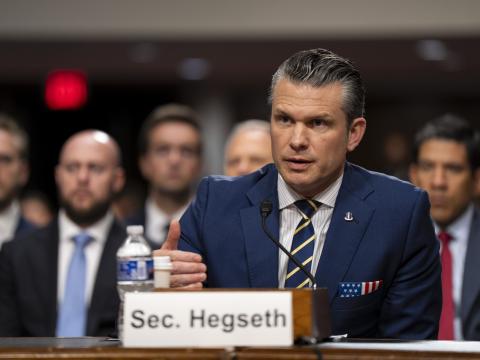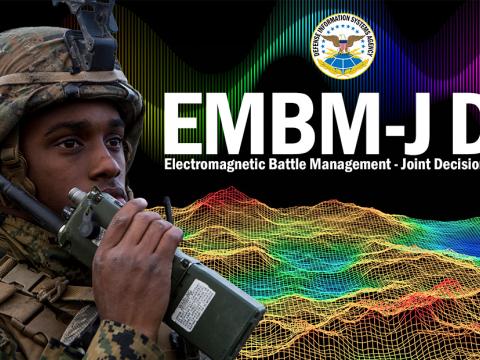Urban Combat Mission Rehearsals Begin
The stage is set; props are ready–lights, camera, action.
Thirty miles outside Louisville, Kentucky, normally there is no noise at all, or just the occasional bird or maybe the wind, but when the curtain rises at the Zussman Urban Combat Training Center, the scene is transformed into total chaos. Explosions, fire, smoke and noise flood the senses. Telephone poles topple, cars careen out of control, and commanders test the mettle of their troops.
The new 26-acre center is the U.S. Defense Department’s response to the rapid urbanization of the world’s likely hot spots. It provides a unique environment for teaching individual and collective technical and tactical skills for urban military or paramilitary deployments. This center supports mounted, dismounted, special operations and combined forces training for operations in scenarios ranging from urban unrest, peacekeeping missions and hostage recovery to mid-intensity combat.
A deployed force in training at the Zussman facility experiences the total impact of a broad spectrum of urban environments. The city’s 21 structures, intact as well as battle-impacted, are designed and constructed to resemble a typical urban area. Structures include air traffic support facilities; an industrial area; a well-developed business area; municipal buildings, including a three-story embassy; a residential area complete with a modern two-story school; and a complex system of roadways that has been bombarded with several hundred tons of combat debris. Urban support facilities, such as a subway entrance; a soccer field that is large enough on which to land a helicopter; an open-air market as well as power, water and sewer plants all provide the backdrop for troops to rehearse the response to the city dweller’s worst nightmare.
Every detail has been carefully planned, from the color-coded building facades to the furniture installed inside to trip up the unwary and hide friend-or-foe targetry.
To stage a realistic training exercise, a battery of special effects is available. The prop inventory includes a bridge that blows up and burns; five burn-on-command buildings; move-and-burn-on-command cars; interior and exterior nontoxic smoke, color and sound confusion effects; collapsing and exploding telephone poles with dancing electrical lines; and a gas station that blows up, causing a river of fire to cross a primary road. All of this can be choreographed to both wide area and specific point sound effects. Well beyond uncomfortably realistic, the sewer system—filled with varying depths of dirty, stink-perfumed water as well as other realistic effects that are normally found in such a place—links key areas of the city underground. These underground areas also can be filled with smoke at a unit commander’s discretion.
Units with limited training objectives may elect to face a single structure or any mixture of allocated structures. The facility can support four separate company-sized units simultaneously, each with a defined area of operation or a battalion task force taking on the entire facility.
In planning for the performance evaluation that follows the mission rehearsal, a commander can select from 10 different video feeds for taping, computer reports provided in either CD-ROM or printout formats, and staff observations. A high-technology command and control facility, which is disguised as the town’s water tower and supported by video feeds, computer monitoring stations and a large, detailed mock-up of the facility contribute to the evaluation process.
The U.S. Army Corps of Engineers managed the construction of the $13.5 million facility, and Redstone Arsenal and the Army Aviation and Missile Command, both in Alabama, prepared the instrumentation and software for the facility. NCCIM LLC, a joint venture formed in 1997 between Nichols Research Corporation and COLSA Corporation, both headquartered in Huntsville, Alabama, provided the audio and video systems for the Zussman facility. In 1999, Computer Sciences Corporation (CSC) and Nichols merged under the CSC name. Nichols’ portion of the joint venture is now owned by CSC.
The front end of the system, located in the control tower, is run by two software applications: One operates the audio effects, and the second controls the sensors, video and targetry throughout every room in each building. Targetry, video cameras and sensors are modular and are custom installed in each room as well as around the facility. Once the mission-specific equipment is installed, the commander can program the complete training scenario from two computer screens in the command center in as little as an hour.
NCCIM programmers created the targetry, video and sensor control software application from software developer Wonderware’s In Touch and In Control applications. These are industrial control applications that allow the programmer to customize the software to control large-scale facilities such as a factory or a prison.
To design a scenario, the user clicks on each building from an overview of the city. By continually clicking, various in-depth views of the floors and rooms can be accessed. Once in a room, the user can select the targets and sensors necessary for the scenario through drag-and-drop programming. For example, commanders can drag the target or video control to where they want it, program it for when it should come up or go down, and note how many kills will be required for that target. The video cameras can be programmed to record for a specific duration once a sensor is tripped.
The audio control system for the training site features a universal digital audio processing system (UDAPS) from Innovative Electronic Designs Incorporated, a Louisville-based company that specializes in computer-controlled sound systems. UDAPS is a digital signal processing (DSP)-based system that provides audio routing, mixing, level control, equalizer, delay, announcement distribution and paging, all in the digital domain. UDAPS for the Zussman center can dynamically route one or any combination of 24 input sources to any individual or group of 32 zone outputs.
The UDAPS delay and DSP functions also provide cross-fading for the fly-around effects and can provide contact closure interface for remote triggering of effects. The UDAPS configuration is controlled by graphical software on the computer system. The custom software package allows the user to configure and monitor an entire training scenario, which includes selecting and scheduling the sound effects and choosing the zones in which they will play. The software also enables a DSP probe to allow the user to listen to the sound effects at any point in the system over the monitor speaker at the computer.
A third system, which is totally under manual control, runs the exploding and pneumatic effects such as the moving and burning cars, collapsing bridge and burning buildings. These effects cannot be left under the blind-run control of a software application. Even after the software gives a Go command, the maneuver observers watch the situation surrounding a manual effect and give the green light at ground level. The Go commands are radioed to the control tower, and the effect is manually triggered.
Each room in every building is wired for the installation of the commander’s selection of targetry, effects and video; however, sensors are all permanently installed in each room. The commander can custom install an array of modular equipment then program the computer control of the training areas. External areas can be as small as an alley or as a large as a street, traffic circle or the sewer and subway system. Once the area is selected and the equipment is installed, the commander can commence scenario programming for the selected area.
Sensor information generated from all of the programmed areas during a training exercise is fed back to the control tower where it is stored on 10 6-gigabyte computer hard drives. For example, sensors gather data on the amount of time soldiers spend in the environment to accomplish the mission and the number of shots fired. In addition, video recorders capture all of the events in each area during a training scenario.
The primary function of the video system is to record all of the information generated from each camera onto a hard drive. The system allows for detailed recording of all audio and video information and subsequent fast editing capabilities to create an accurate record of the training scenario. Secondarily, video is routed to the closed-circuit cable system so viewers can watch everything as it happens from each camera on multiple screens.
During a training scenario, the room or area sensors determine which cameras are going ‘hot’ on the network. The sensor information is routed to the system’s computer file structure. The video and the time line information are stored in the file structure according to the information’s area of origin. In video editing, the files from the time line are dragged and dropped to prepare a scenario movie for the commander to review with his troops. The final edit is either burned to digital versatile disc (DVD)-read only memory, or to a very high-speed tape, or transmitted over the closed-circuit cable system to the training review theater.
Once the timed, triggered and manual audio effects are programmed into the system and the scenario is set to run, audio is distributed via miles of fiber runs. The 25 exterior audio zones throughout the facility have 70 permanently installed military-specification, weather-resistant Technomad Paris 616T loudspeakers powered with Crown Comtech amplifiers. These speakers must withstand exhaust heat and smoke, compounded by the smoke generated from explosions, flares, smoke grenades and canon fire. Four Paris speakers can effectively cover an entire street. An additional 16 Technomad Cairo 15/C loudspeakers powered by Crown K2 amplifiers provide sound effects in close-quarter, stairwell and hallway grenade-drop audio zones.
“The playback is very life-like, therefore very effective,” Mark Seeber, NCCIM senior systems analyst, states. “In one demonstration, I was playing a mixed combination of vehicles and machinery, crowd noises such as multiple conversations and people milling about as well as a significant amount of nature sounds. I walked a large part of the facility with several commanders who commented that they couldn’t hear the audio program, just all the background noise. Then, I stopped the audio program and there was nothing, no noise at all. I essentially had the commanders psychologically convinced that a lot was happening out here, until I shut it all off.”
The center is named after World War II Medal of Honor recipient 2nd Lt. Raymond Zussman, USA.
Christopher Buttner is a freelance writer who specializes in covering high-technology systems installations and sound reinforcement.




Comments